Performance of Sustainable Green Concrete Incorporating Quarry Dust and Ferronickel Slag as Fine Aggregate
Abstract
:1. Introduction
2. Materials and Methods
2.1. Materials
2.1.1. Binder
2.1.2. Fine and Coarse Aggregates
2.2. Concrete Mix Details
2.3. Concrete Mixing and Casting
2.4. Test Methods
2.4.1. Fresh Concrete Testing
2.4.2. Mechanical Properties
Uniaxial Compressive Strength
Splitting Tensile Strength
2.4.3. Drying Shrinkage
2.4.4. Microstructural Investigation
3. Results and Discussion
3.1. Fresh Properties
3.2. Mechanical Properties
3.2.1. Compressive Strength
3.2.2. Splitting Tensile Strength
3.2.3. Correlation between Tensile and Compressive Strengths
3.3. Drying Shrinkage
3.4. Microstructural Properties
3.5. Crystallographic Phase Identification
4. Conclusions
- Combining quarry dust and nickel slag provides a well-graded distribution of particles that are compliant with AS 2758.1. This results in a denser packing of particles with less voids in comparison to natural sand.
- Use of quarry dust and nickel slag as fine aggregate produced a higher uniaxial compressive strength of concrete than that using sand. Specifically, QD25-FNS75 had the highest compressive strength, which was 16% greater than the control specimen QD0-FNS0. This is attributed to the rough texture and angular shape of both quarry dust and nickel slag providing a better packing and mechanical interlocking of aggregate.
- Similarly, the combined use of quarry dust and nickel slag produced higher tensile strengths than the control specimen. The mixture QD25-FNS75 produced the highest tensile strength, which was 20% more than the control specimen.
- Mixture QD25-FNS75 had the least shrinkage over the 56 days. The high water absorption of quarry dust caused the QD75-FNS25 and QD50-FNS50 specimens to shrink more than the control specimen.
- In the microstructural investigations, specimens with QD and FNS exhibited fewer voids and a more compact surface compared to the control specimen. This finding is aligned with the mechanical properties observed in this study.
Author Contributions
Funding
Institutional Review Board Statement
Informed Consent Statement
Data Availability Statement
Conflicts of Interest
References
- AS 2758.1; Aggregates and Rock for Engineering Purposes—Concrete Aggregates. Standard Australia Limited: Sydney, NSW, Australia, 2014.
- Martínez-García, R.; Rojas, M.I.S.; Pozo, J.M.M.; Fraile-Fernandez, F.J.; Juan-Valdes, A. Evaluation of mechanical characteristics of cement mortar with fine recycled concrete aggregates (FRCA). Sustainability 2021, 13, 414. [Google Scholar] [CrossRef]
- Krause, J.C.; Diesing, M.; Arlt, G. The physical and biological impact of sand extraction: A case study of the western Baltic Sea. J. Coast. Res. 2010, 51, 215–226. [Google Scholar]
- Boyd, S.E.; Limpenny, D.S.; Rees, H.L.; Cooper, K.M. The effects of marine sand and gravel extraction on the macrobenthos at a commercial dredging site (results 6 years post-dredging). ICES J. Mar. Sci. 2005, 62, 145–162. [Google Scholar] [CrossRef]
- Nuruzzaman, M.; Salauddin, M. Application of recycled aggregate in concrete: A review. In Proceedings of the 3rd International Conference on Advances in Civil Engineering, Cox’s Bazar, Bangladesh, 21–23 December 2016. [Google Scholar]
- Hilburg, J. Concrete Production Produces Eight Percent of the World’s Carbon Dioxide Emissions. The Architect’s Newspaper, 2 January 2019. [Google Scholar]
- Glosserman, B. Hard to Believe, but we’re Running out of Sand. The Japan Times, 4 May 2021. [Google Scholar]
- Coviello, C.G.; Lassandro, P.; Sabbà, M.F.; Foti, D. Mechanical and Thermal Effects of Using Fine Recycled PET Aggregates in Common Screeds. Sustainability 2023, 15, 16692. [Google Scholar] [CrossRef]
- Lerna, M.; Foti, D.; Petrella, A.; Sabbà, M.F.; Mansour, S. Effect of the Chemical and Mechanical Recycling of PET on the Thermal and Mechanical Response of Mortars and Premixed Screeds. Materials 2023, 16, 3155. [Google Scholar] [CrossRef] [PubMed]
- Patel Kirtan, R.; Shah, S. State of the art review on utilization of quarry waste replaceing fine aggregate in concrete. Int. J. Res. Eng. Technol. 2015, 4, 167–171. [Google Scholar]
- Kadir, A.A.; Hassan, M.I.H.; Sarani, N.A.; Rahim, A.S.A.; Ismail, N. Physical and mechanical properties of quarry dust waste incorporated into fired clay brick. AIP Conf. Proc. 2017, 1835, 020040. [Google Scholar] [CrossRef]
- Wellala, D.P. Use of Quarry Rock Dust as a Fine Aggregate in Concrete. Master’s Thesis, Curtin University, Bentley, Australian, 2017. [Google Scholar]
- Muhit, I.B.; Raihan, M.T.; Nuruzzaman, M. Determination of mortar strength using stone dust as a partially replaced material for cement and sand. Adv. Concr. Constr. 2014, 2, 249. [Google Scholar] [CrossRef]
- Nuruzzaman, M.; Islam, M.; Salauddin, M. Strength aspect of concrete using stone dust as a partial replacement of sand. Int. J. Adv. Struct. Geotech. Eng. 2015, 4, 237–242. [Google Scholar]
- Saha, A.K.; Sarker, P.K. Sustainable use of ferronickel slag fine aggregate and fly ash in structural concrete: Mechanical properties and leaching study. J. Clean. Prod. 2017, 162, 438–448. [Google Scholar] [CrossRef]
- Saha, A.K.; Majhi, S.; Sarker, P.K.; Mukherjee, A.; Siddika, A.; Aslani, F.; Zhuge, Y. Non-destructive prediction of strength of concrete made by lightweight recycled aggregates and nickel slag. J. Build. Eng. 2021, 33, 101614. [Google Scholar] [CrossRef]
- Nuruzzaman, M.; Ahmad, T.; Sarker, P.K.; Shaikh, F.U.A. Rheological behaviour, hydration, and microstructure of self-compacting concrete incorporating ground ferronickel slag as partial cement replacement. J. Build. Eng. 2023, 68, 106127. [Google Scholar] [CrossRef]
- Nuruzzaman, M.; Sarker, P.K.; Shaikh, F.U.A. The interfacial transition zone microstructure of ground ferronickel slag incorporated self-compacting concrete investigated by nanoindentation. J. Build. Eng. 2023, 71, 106437. [Google Scholar] [CrossRef]
- Nuruzzaman, M.; Casimiro, J.O.C.; Sarker, P.K. Fresh and hardened properties of high strength self-compacting concrete using by-product ferronickel slag fine aggregate. J. Build. Eng. 2020, 32, 101686. [Google Scholar] [CrossRef]
- Katsiotis, N.S.; Tsakiridis, P.E.; Velissariou, D.; Katsiotis, M.S.; Alhassan, S.M.; Beazi, M. Utilization of Ferronickel Slag as Additive in Portland Cement: A Hydration Leaching Study. Waste Biomass Valorization 2015, 6, 177–189. [Google Scholar] [CrossRef]
- Shoya, M.; Sugita, S.; Tsukinaga, Y.; Aba, M.; Dhir, K.T.R.K.; Jappy, T.G. Properties of Self-Compacting Concrete with Slag Fine Aggregates, in Exploiting Wastes in Concrete; Thomas Telford Publishing: London, UK, 1999; pp. 121–130. [Google Scholar]
- AS 3972; General Purpose and Blended Cements. Standards Australia: Sydney, NSW, Australia, 2010.
- ASTM C150/C150M-20; Standard Specification for Portland Cement. ASTM International: West Conshohocken, PA, USA, 2020.
- AS 1141.11.1; Methods for Sampling and Testing Aggregates, Method 11.1: Particle Size Distribution—Sieving Method. Standard Australia Limited: Sydney, NSW, Australia, 2020.
- AS 1141.5; Method for Sampling and Testing Aggregates, Method 5: Particle Density and Water Absorption of Fine Aggregate. Standard Australia Limited: Sydney, NSW, Australia, 2000.
- AS 1141.6.2; Methods for Sampling and Testing Aggregates, Method 6.2: Particle Density and Water Absorption of Coarse Aggregate—Pycnometer Method. Standard Australia Limited: Sydney, NSW, Australia, 1996.
- AS 1012.3.1; Methods of Testing Concrete, Method 3.1: Determination of Properties Related to the Consistency of Concrete—Slump Test. Standard Australia Limited: Sydney, NSW, Australia, 2014.
- AS 1012.9; Methods of Testing Concrete, Method 9: Compressive Strength Tests—Concrete, Mortar and Grout Specimens. Standard Australia Limited: Sydney, NSW, Australia, 2014.
- AS 1012.10; Methods of Testing Concrete, Method 10: Determination of Indirect Tensile Strength of Concrete Cylinders (‘Brazil’ or Splitting Test). Standard Australia Limited: Sydney, NSW, Australia, 2000.
- AS 1012.8.4; Methods of Testing Concrete Method for Making and Curing Concrete—Drying Shrinkage Specimens Prepared in the Field or in the Laboratory. Standard Australia Limited: Sydney, NSW, Australia, 2015.
- de Castro, S.; de Brito, J. Evaluation of the durability of concrete made with crushed glass aggregates. J. Clean. Prod. 2013, 41, 7–14. [Google Scholar] [CrossRef]
- Hewlett, P. Relating Concrete Performance to Practice. In Role of Concrete In Sustainable Development, Proceedings of the International Symposium dedicated to Professor Surendra Shah, Northwestern University, USA, Scotland, UK, 3–4 September 2003; Thomas Telford Publishing: London, UK, 2003. [Google Scholar]
- Aïtcin, P.C. High Performance Concrete; CRC Press: Boca Raton, FL, USA, 1998; ISBN 9780429204074. [Google Scholar]
- Ahn, N. An Experimental Study on the Guidelines for Using Higher Contents of Aggregate Micro Fines in Portland Cement Concrete; The University of Texas at Austin: Austin, TX, USA, 2000. [Google Scholar]
- Haque, M.; Tuhin, I.; Farid, M. Effect of aggregate size distribution on concrete compressive strength. SUST J. Sci. Technol. 2012, 19, 35–39. [Google Scholar]
- Ukpata, J.O.; Ephraim, M.E. Flexural and tensile strength properties of concrete using lateritic sand and quarry dust as fine aggregate. ARPN J. Eng. Appl. Sci. 2012, 7, 324–331. [Google Scholar]
- Chrysanidis, T. Experimental and numerical research on cracking characteristics of medium-reinforced prisms under variable uniaxial degrees of elongation. Eng. Fail. Anal. 2023, 145, 107014. [Google Scholar] [CrossRef]
- AS 3600; Concrete Structures. Standards Australia: Sydney, NSW, Australia, 2009.
- Tangchirapat, W.; Jaturapitakkul, C. Strength, drying shrinkage, and water permeability of concrete incorporating ground palm oil fuel ash. Cem. Concr. Compos. 2010, 32, 767–774. [Google Scholar] [CrossRef]
- Jiang, C.; Guo, W.; Chen, H.; Zhu, Y.; Jin, C. Effect of filler type and content on mechanical properties and microstructure of sand concrete made with superfine waste sand. Constr. Build. Mater. 2018, 192, 442–449. [Google Scholar] [CrossRef]
- Yang, L.; Shi, C.; Wu, Z. Mitigation techniques for autogenous shrinkage of ultra-high-performance concrete—A review. Compos. Part B Eng. 2019, 178, 107456. [Google Scholar] [CrossRef]
- Rao, G.M.; Rao, T.D.G.; Reddy, M.S.N.; Seshu, D.R. A study on the strength and performance of geopolymer concrete subjected to elevated temperatures. In Recent Advances in Structural Engineering, Volume 1: Select Proceedings of SEC 2016; Springer: Berlin/Heidelberg, Germany, 2019. [Google Scholar]
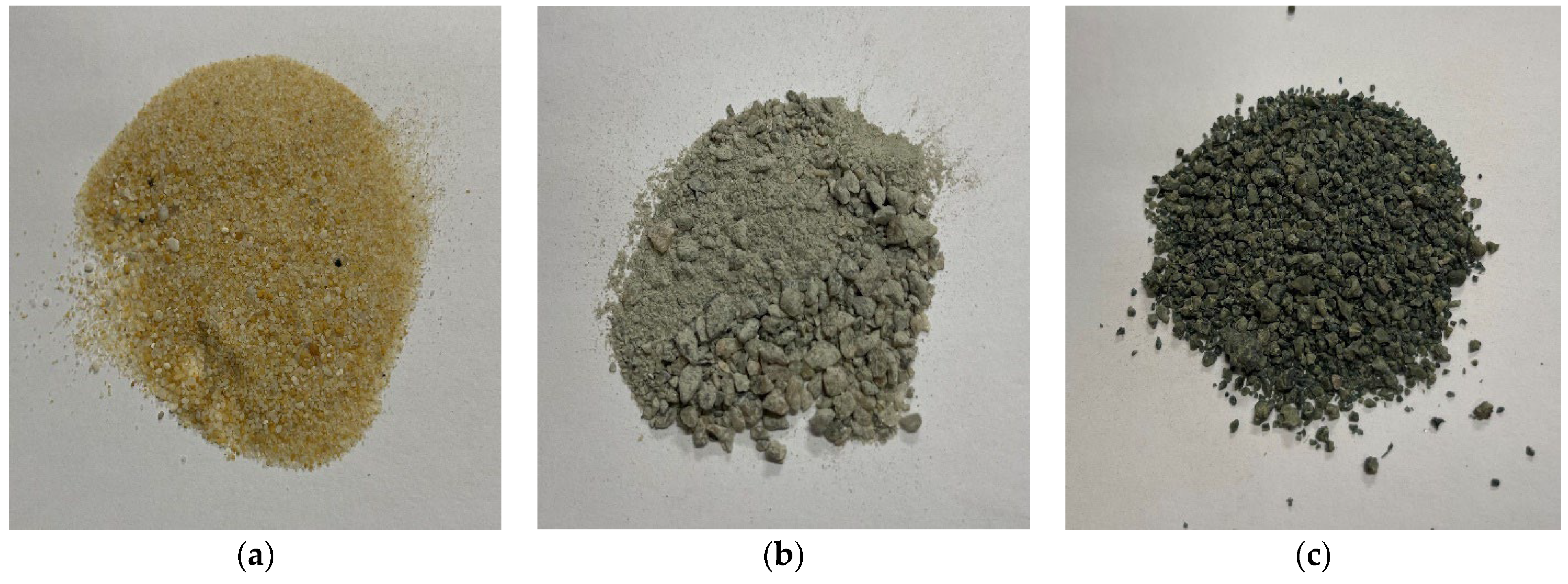
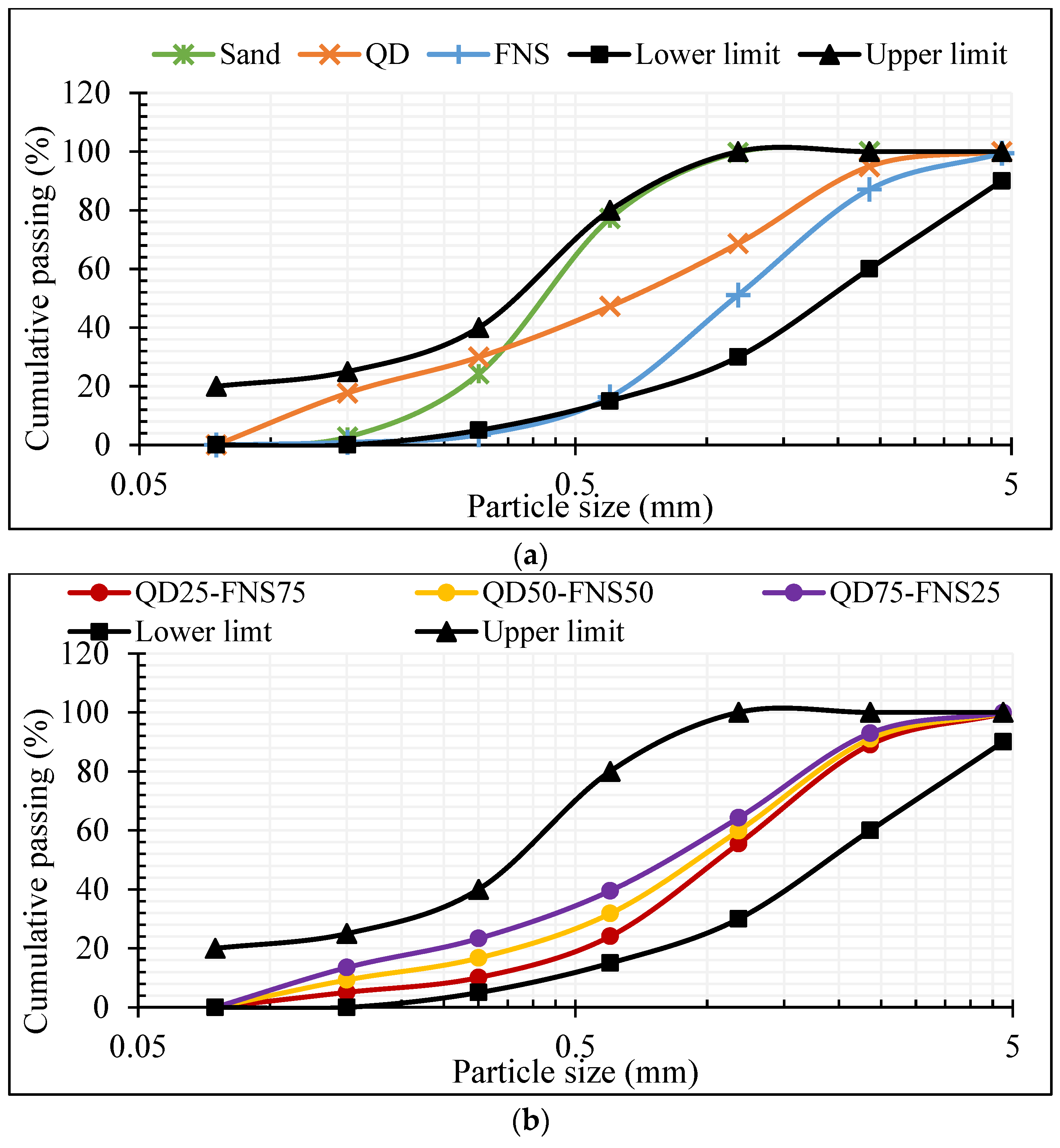


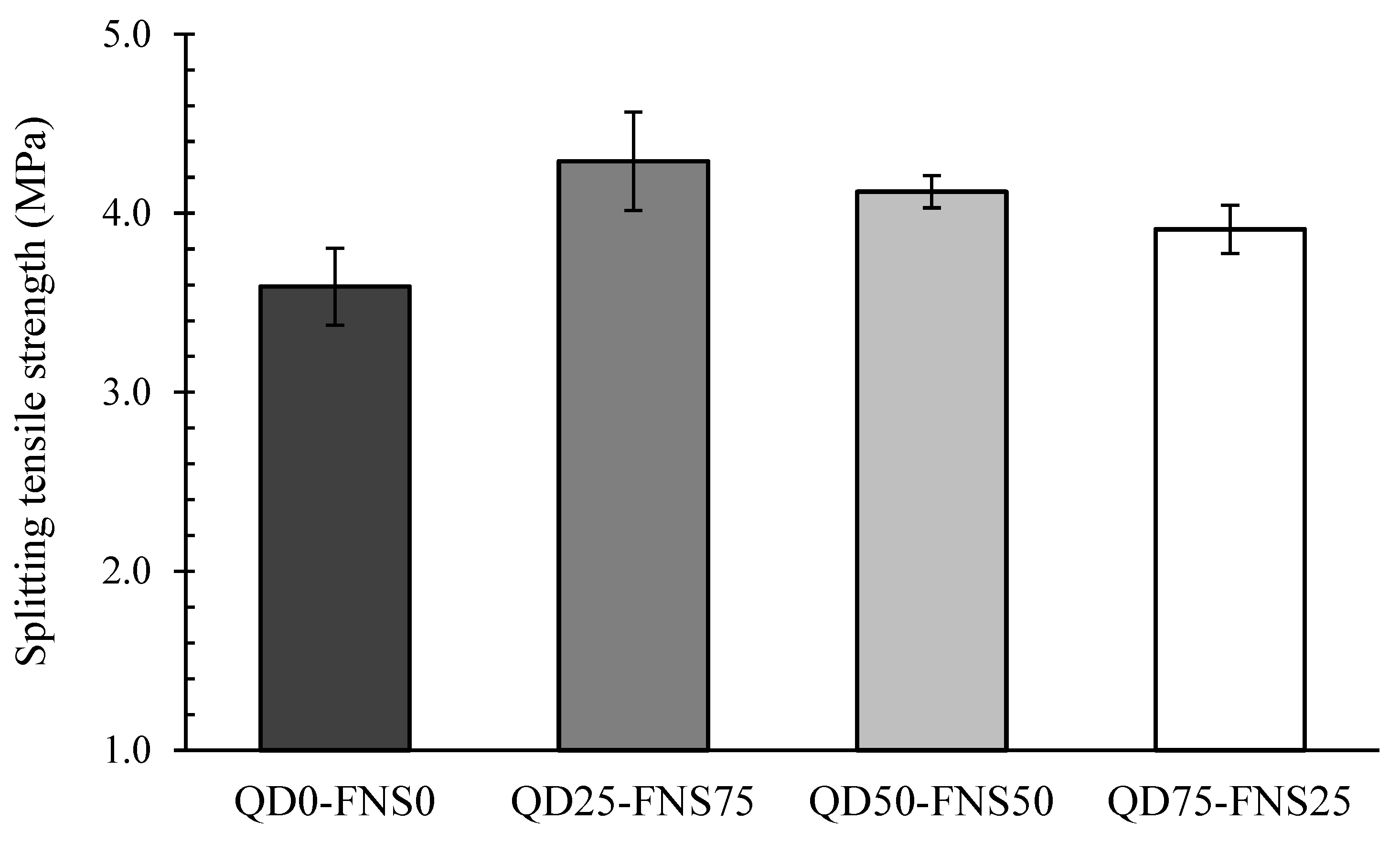
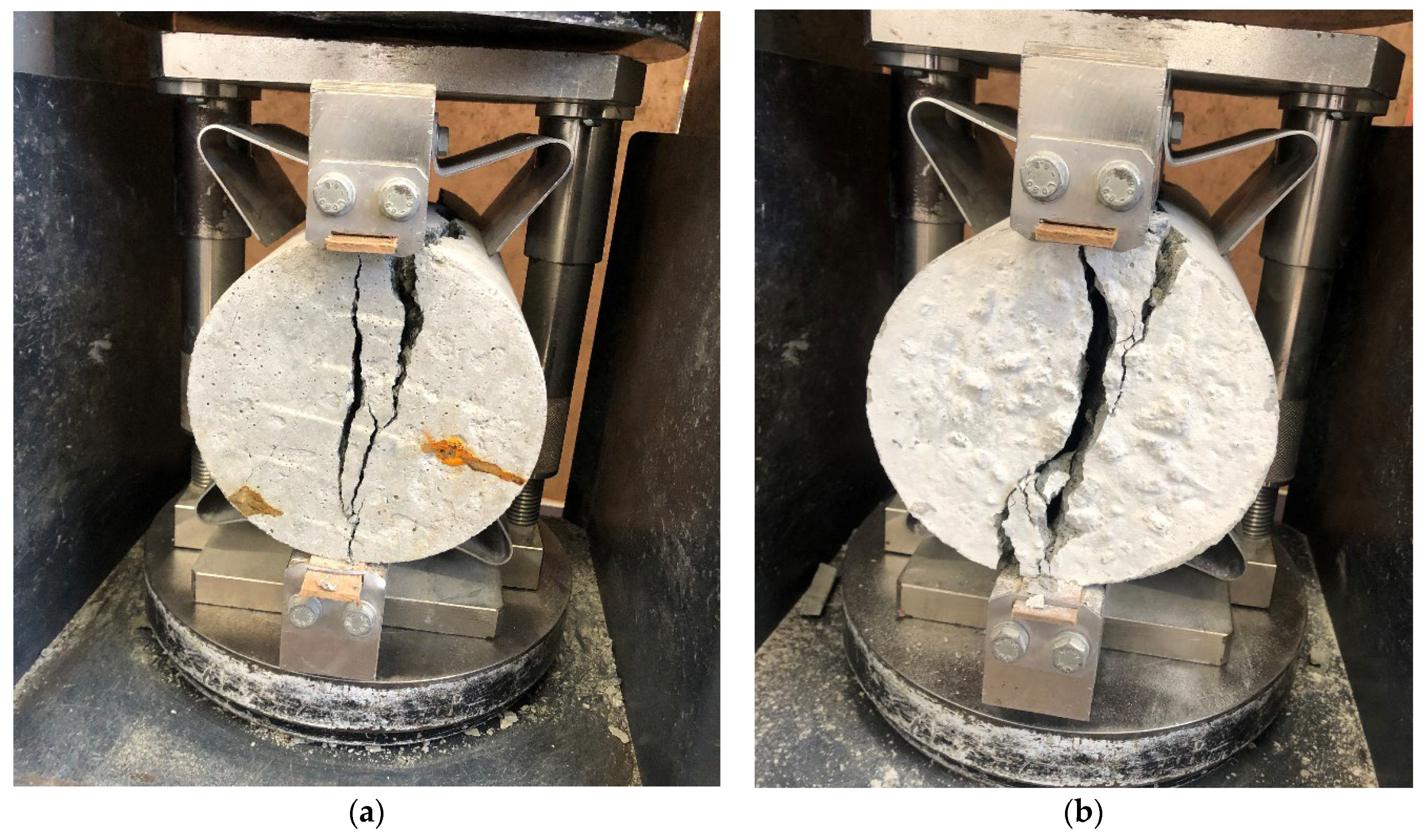

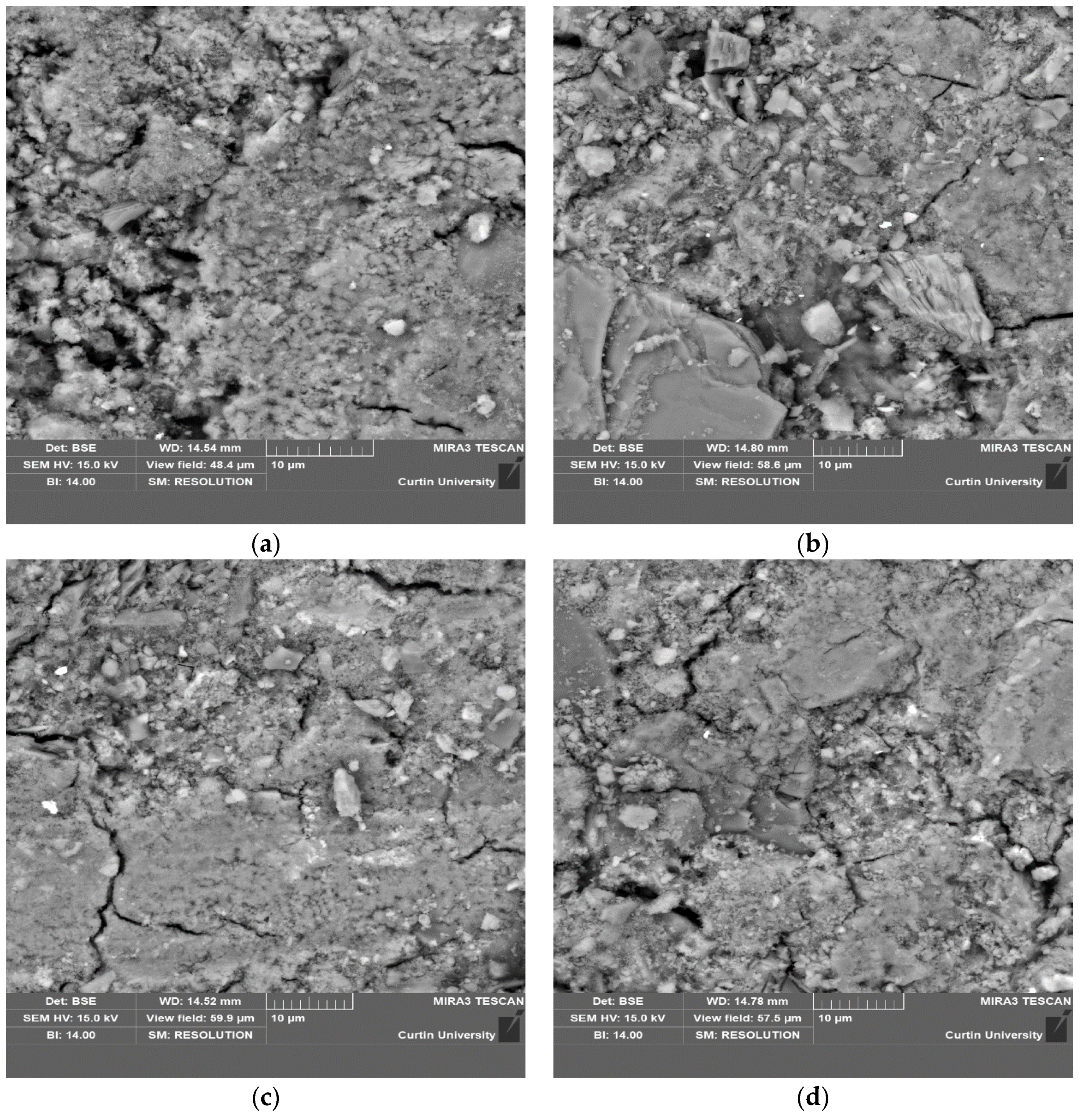
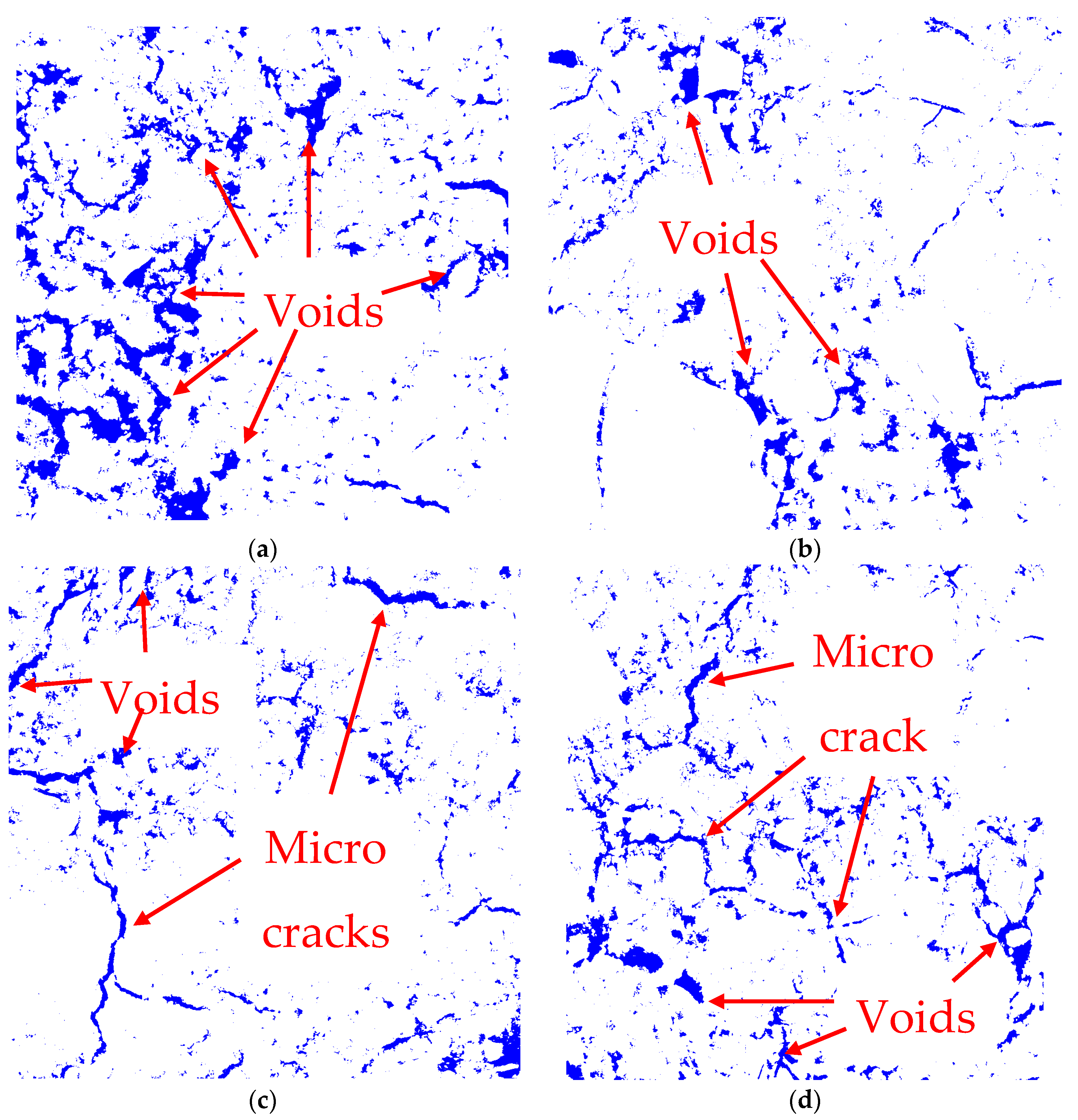


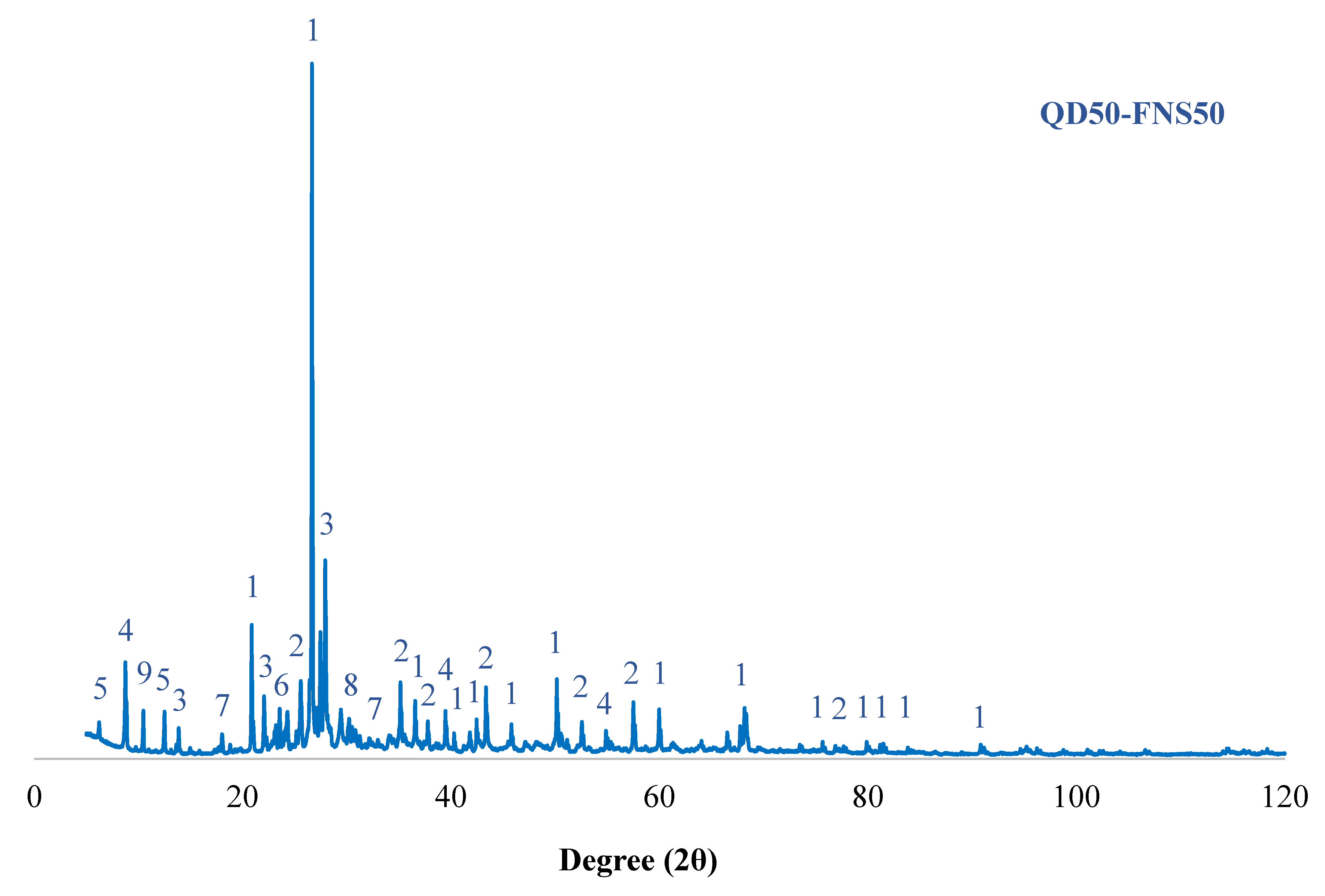
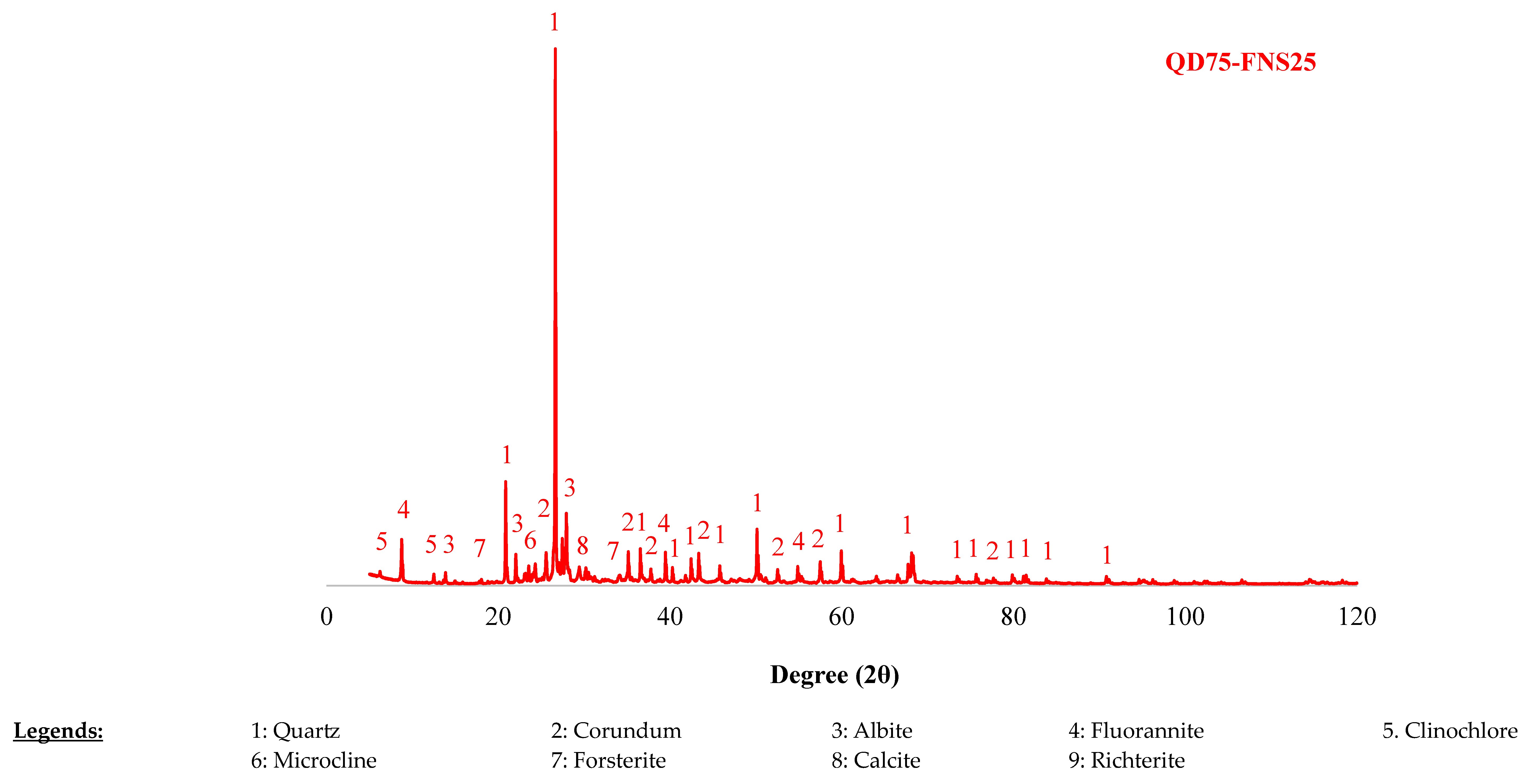
| Aggregate Type | Fineness Modulus (FM) |
|---|---|
| 20 mm Coarse | 6.96 |
| 10 mm Coarse | 6 |
| Sand | 1.96 |
| Quarry Dust | 2.42 |
| Nickel Slag | 3.42 |
| Property | 20 mm | 10 mm | Sand | Nickel Slag | Quarry Dust |
|---|---|---|---|---|---|
| Water Absorption (%) | 0.40 | 0.40 | 0.68 | 0.48 | 3.00 |
| Specific Gravity | 2.73 | 2.66 | 2.6 | 2.82 | 2.49 |
| Mix ID | OPC | Fine Aggregate | Coarse Aggregate | Water | ||
|---|---|---|---|---|---|---|
| Natural Sand | Quarry Dust | Nickel Slag | ||||
| QD0-FNS0 | 400 | 750 | 0 | 0 | 1115 | 180 |
| QD25-FNS75 | 400 | 0 | 187.5 | 562.5 | 1115 | 180 |
| QD50-FNS50 | 400 | 0 | 375 | 375 | 1115 | 180 |
| QD75-FNS25 | 400 | 0 | 562.5 | 187.5 | 1115 | 180 |
| Mix ID | 28 Days Splitting Tensile Strength (MPa) | Experimental/Calculated Ratio | |
|---|---|---|---|
| Experimental | AS 3600 | ||
| QD0-FNS0 | 3.59 | 3.96 | 0.91 |
| QD25-FNS75 | 4.29 | 4.29 | 1.00 |
| QD50-FNS50 | 4.12 | 4.18 | 0.99 |
| QD75-FNS25 | 3.91 | 4.06 | 0.96 |
Disclaimer/Publisher’s Note: The statements, opinions and data contained in all publications are solely those of the individual author(s) and contributor(s) and not of MDPI and/or the editor(s). MDPI and/or the editor(s) disclaim responsibility for any injury to people or property resulting from any ideas, methods, instructions or products referred to in the content. |
© 2024 by the authors. Licensee MDPI, Basel, Switzerland. This article is an open access article distributed under the terms and conditions of the Creative Commons Attribution (CC BY) license (https://creativecommons.org/licenses/by/4.0/).
Share and Cite
Nuruzzaman, M.; Almeida, J.; Amin, M.T.E.; Sarker, P.K. Performance of Sustainable Green Concrete Incorporating Quarry Dust and Ferronickel Slag as Fine Aggregate. Materials 2024, 17, 2326. https://doi.org/10.3390/ma17102326
Nuruzzaman M, Almeida J, Amin MTE, Sarker PK. Performance of Sustainable Green Concrete Incorporating Quarry Dust and Ferronickel Slag as Fine Aggregate. Materials. 2024; 17(10):2326. https://doi.org/10.3390/ma17102326
Chicago/Turabian StyleNuruzzaman, Md, Jaydon Almeida, Md Tanvir Ehsan Amin, and Prabir Kumar Sarker. 2024. "Performance of Sustainable Green Concrete Incorporating Quarry Dust and Ferronickel Slag as Fine Aggregate" Materials 17, no. 10: 2326. https://doi.org/10.3390/ma17102326





